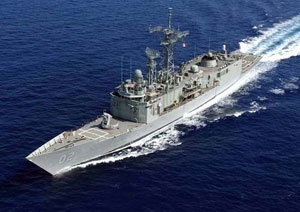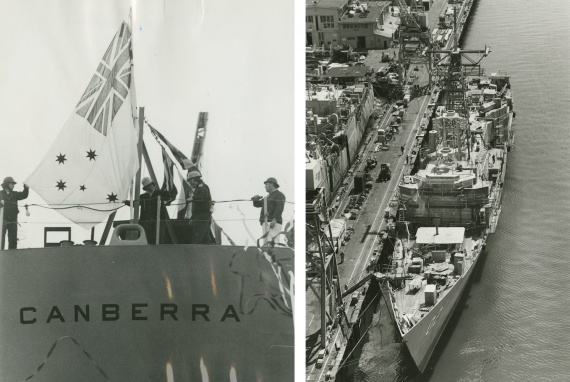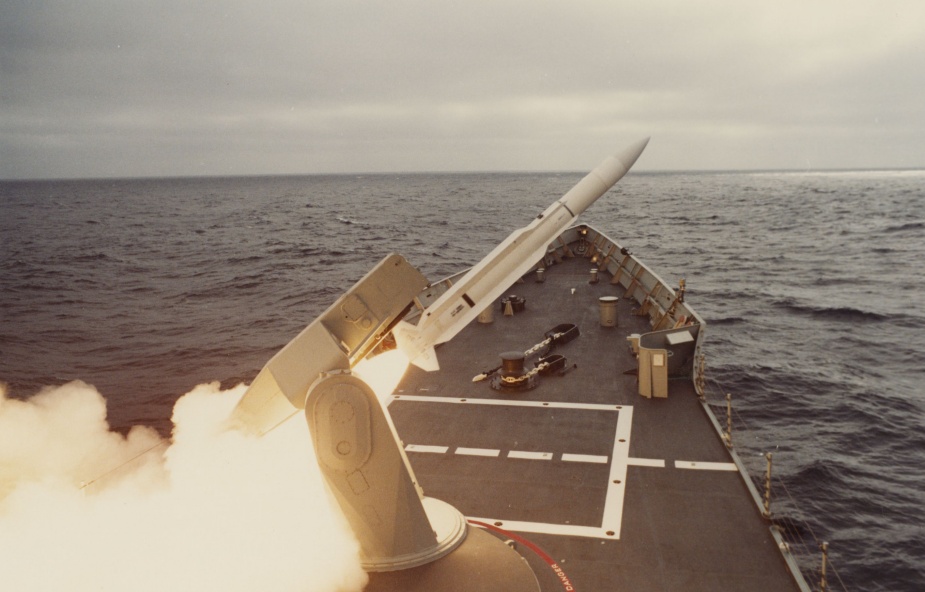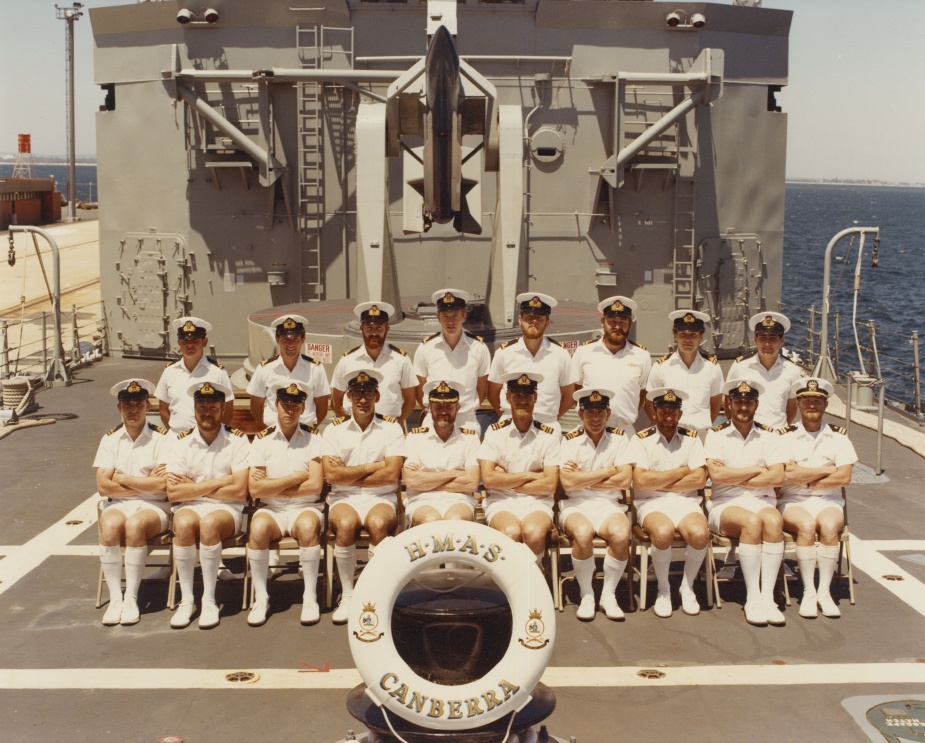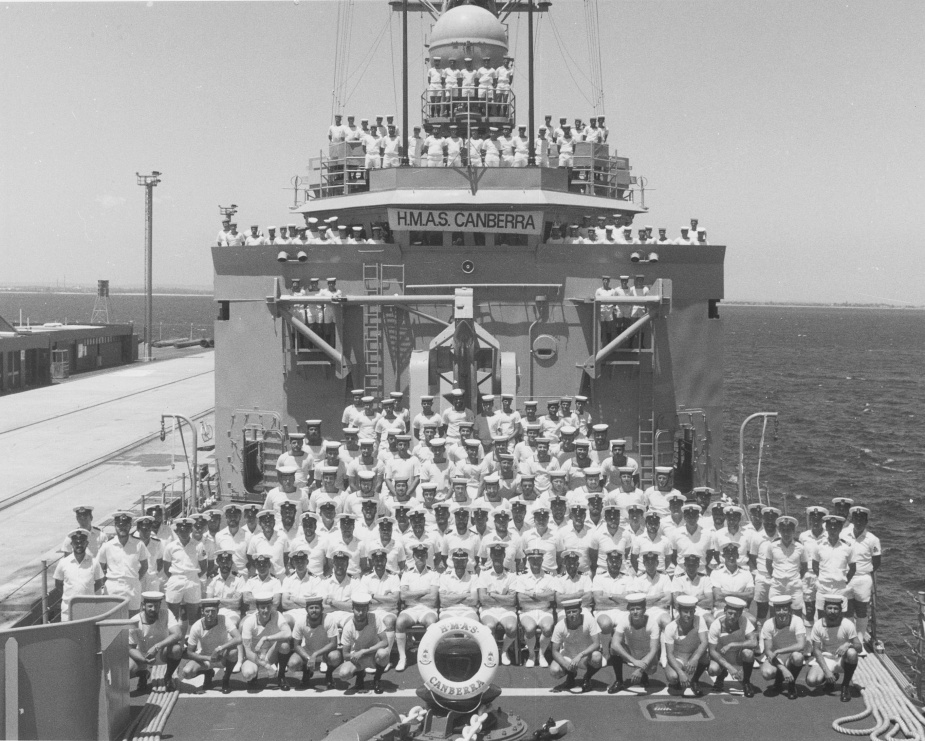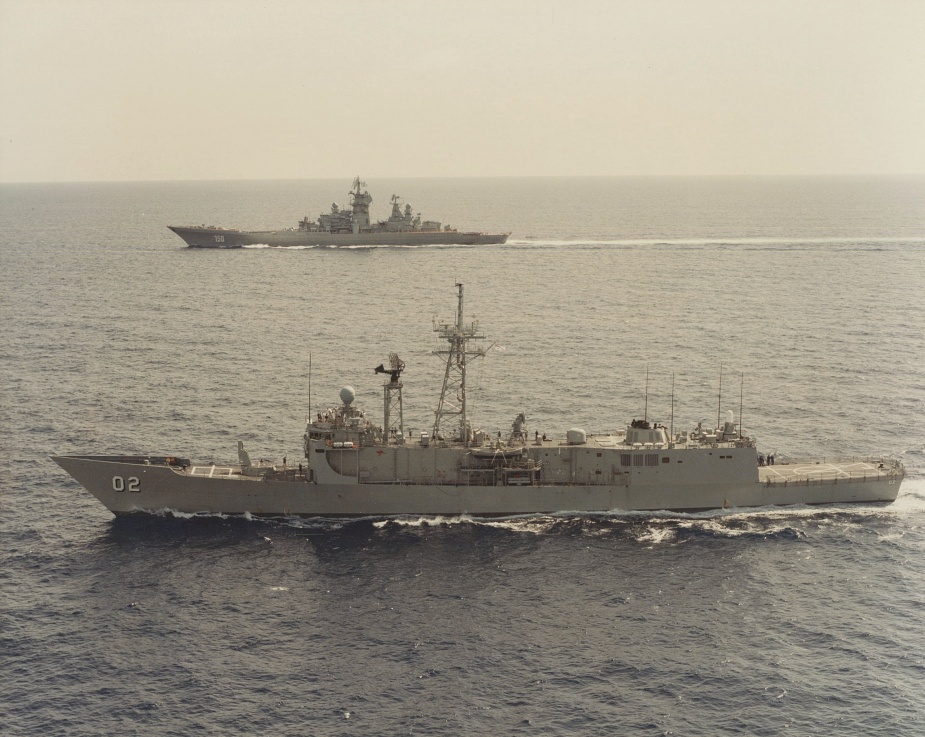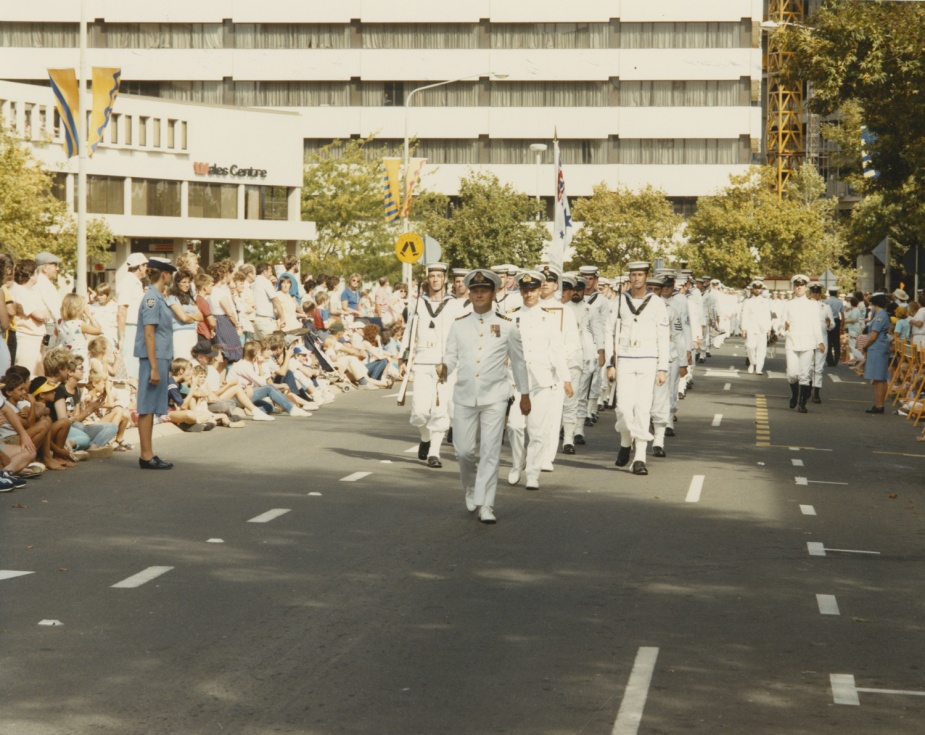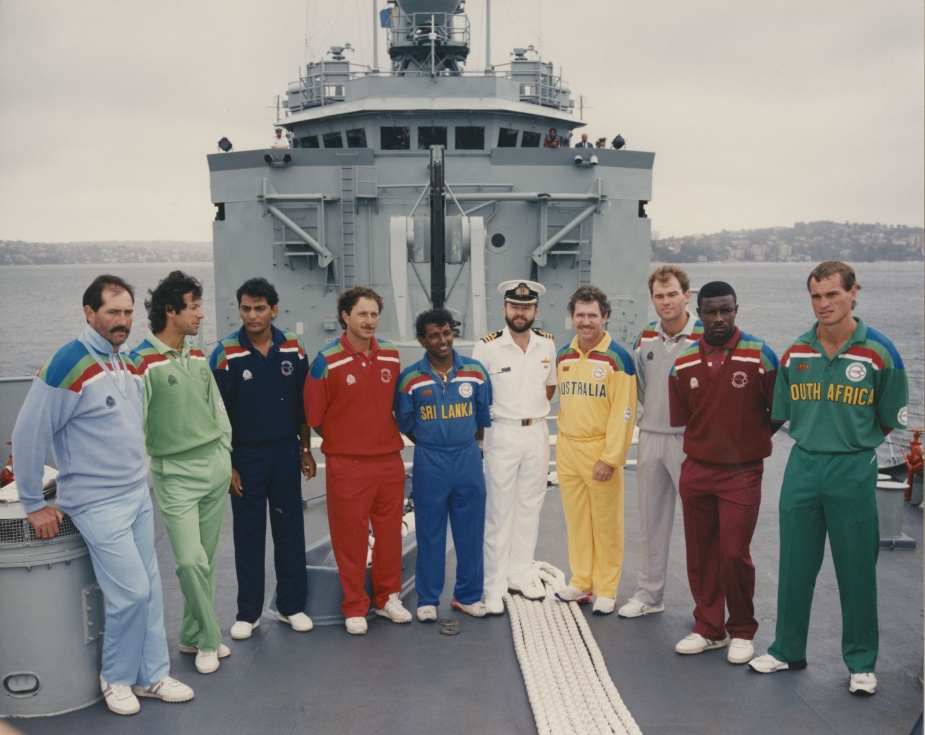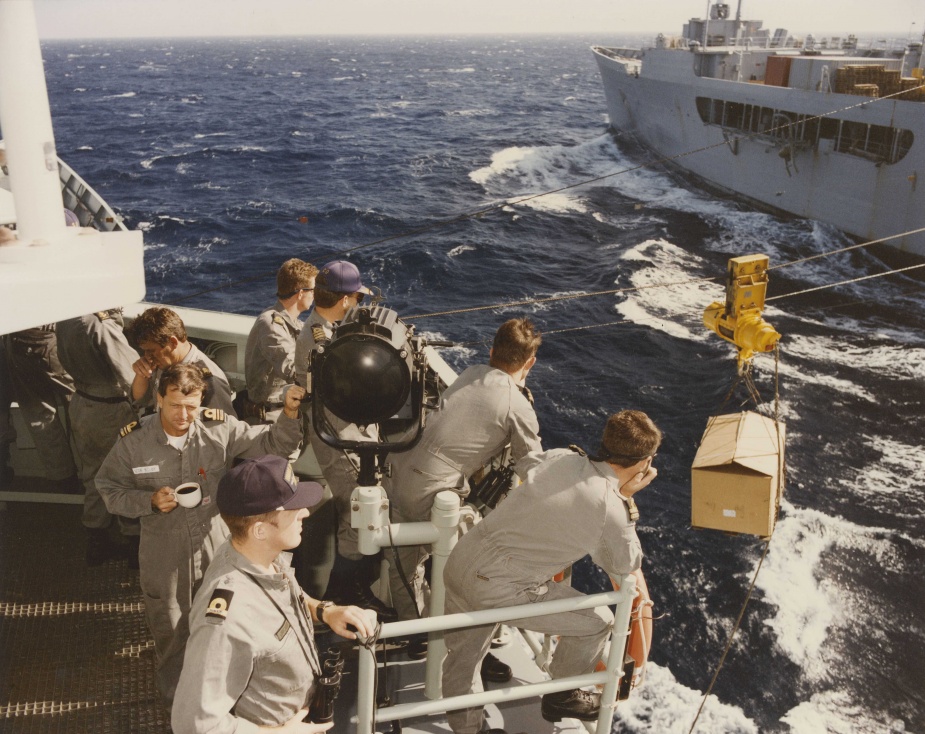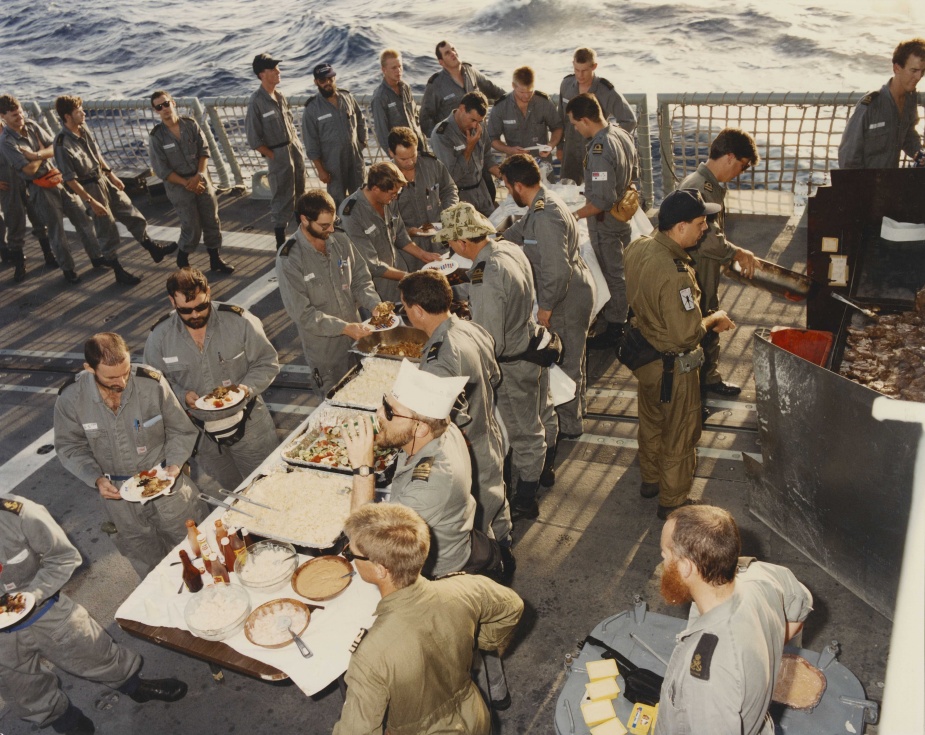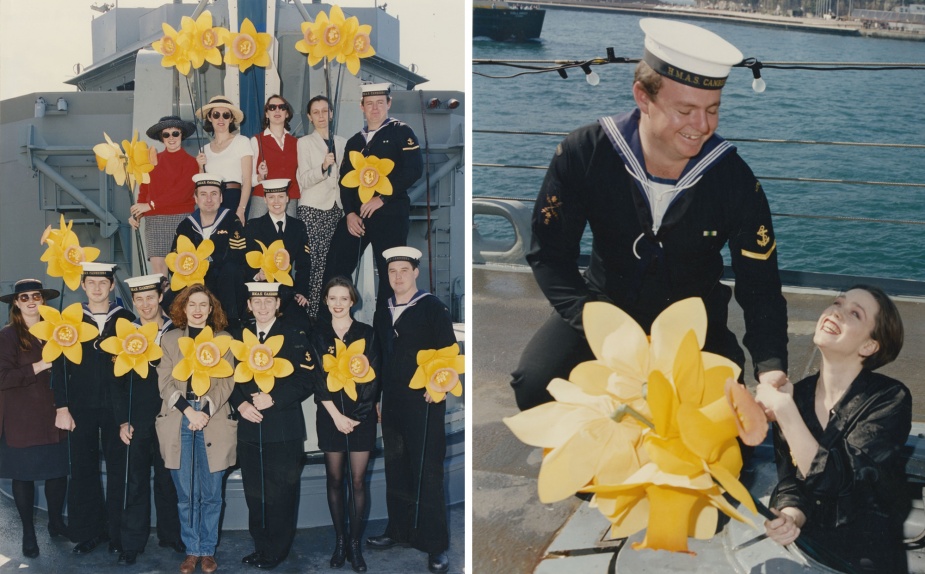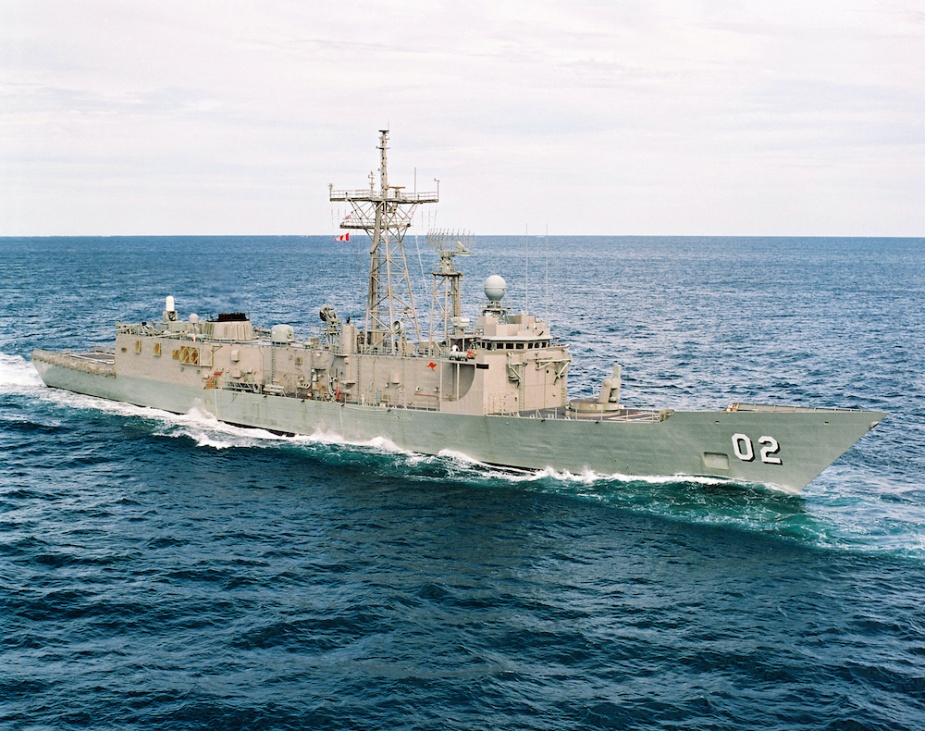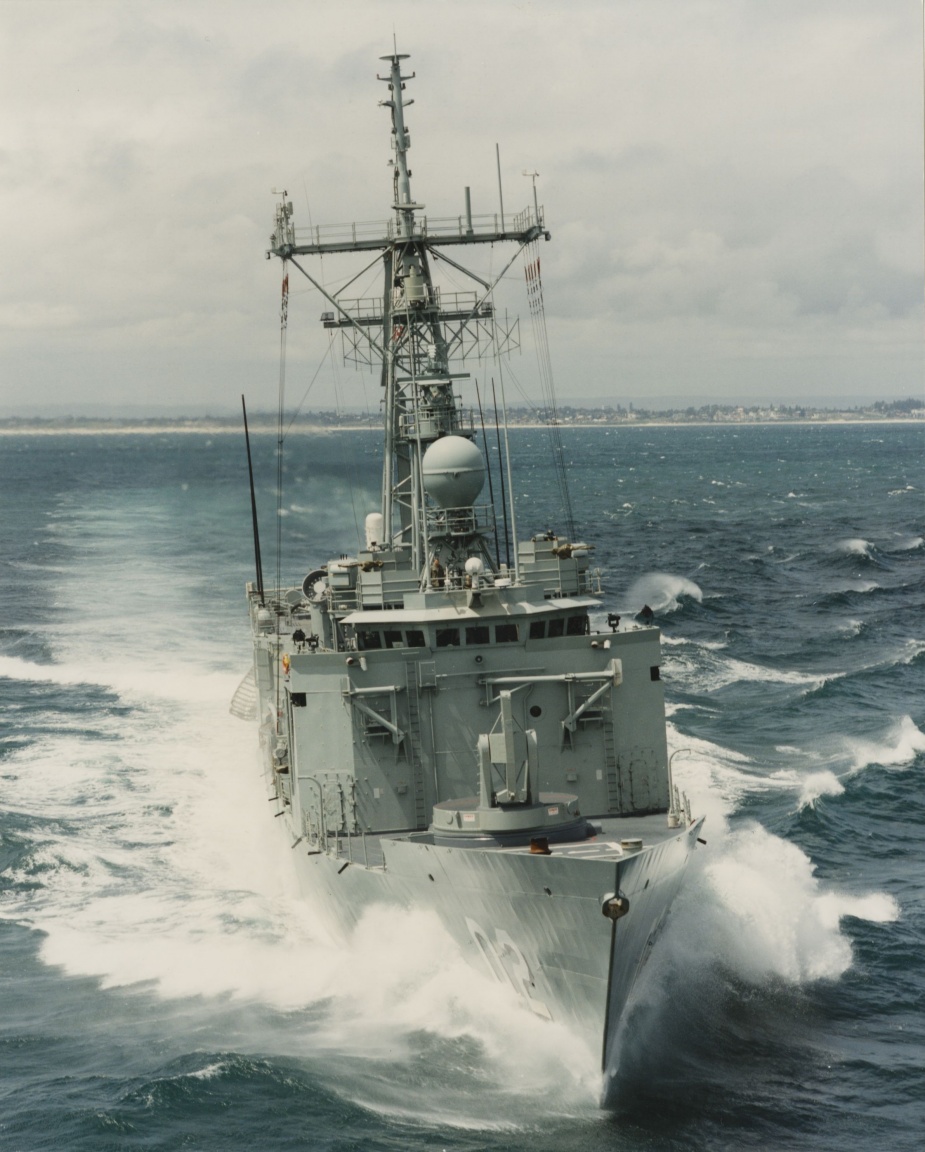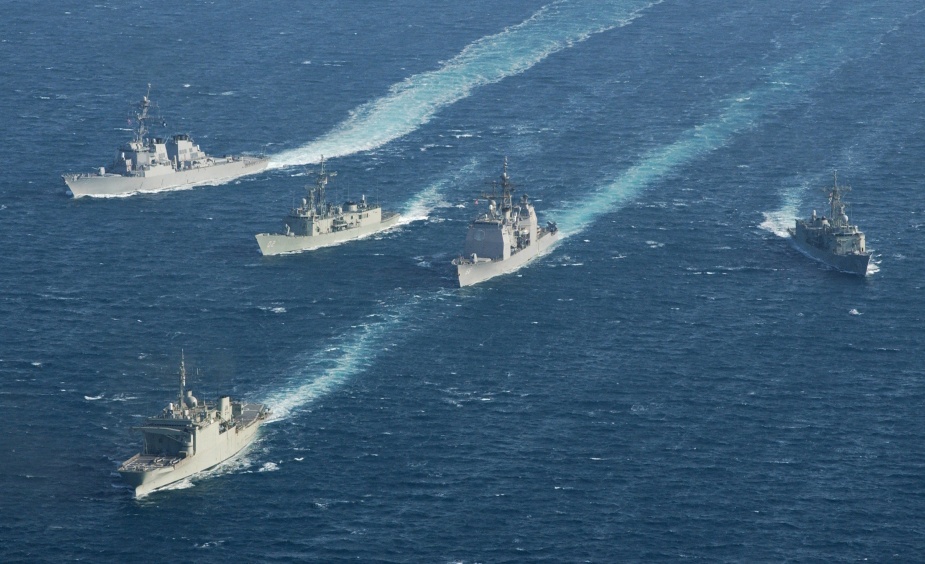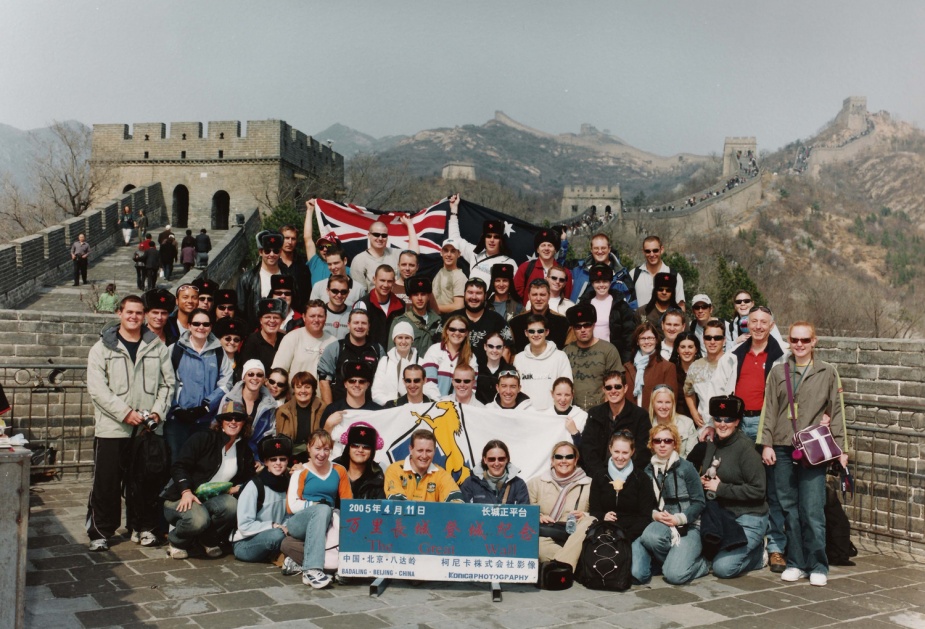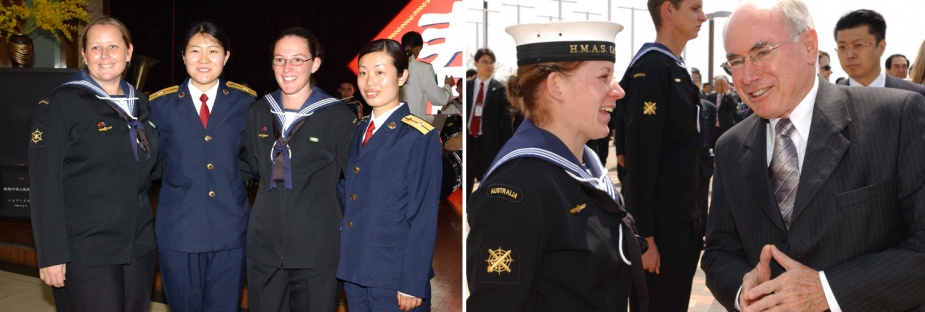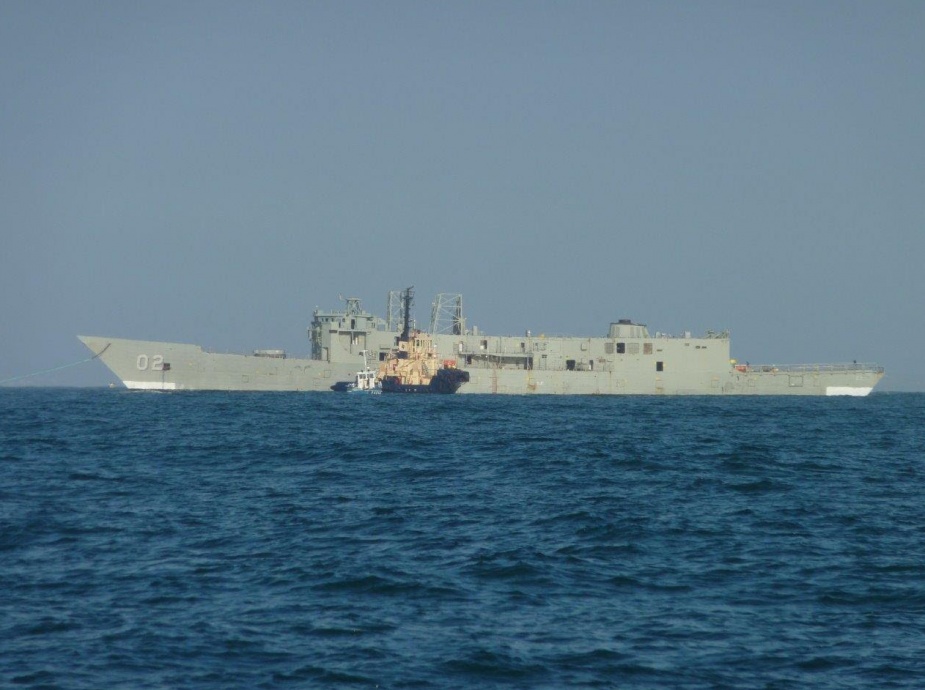HMAS Canberra (II)
| Class |
Adelaide Class |
|---|---|
| Type |
Surface Combatant |
| Pennant |
FFG 02 |
| Motto |
For Queen and Country |
| Launched |
1 December 1978 |
| Commissioned |
21 March 1981 |
| Decommissioned |
12 November 2005 |
| Fate |
Scuttled as dive wreck |
| Dimensions & Displacement | |
| Displacement | 4200 tonnes |
| Length | 138.1 metres |
| Beam | 14.3 metres |
| Performance | |
| Speed | More than 30 knots |
| Embarked Forces | Approximately 221 |
| Propulsion | |
| Machinery | 2 General Electric LM2500 gas turbines geared to a single controllable pitch propeller |
| Armament | |
| Missiles |
|
| Guns | 76mm Rapid Fire Gun |
| Torpedoes |
|
| Other Armament |
|
| Helicopters | Up to two Seahawk helicopters |
| Awards | |
| Inherited Battle Honours | |
| Battle Honours | |
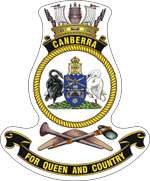
HMAS Canberra (II) was the second of six Adelaide Class guided missile frigates built for the Royal Australian Navy as modified to the design of the American Oliver Hazard Perry Class. The Australian Government ordered two of these ships in February 1976 which were constructed by the Todd Pacific Shipyard Corporation in Seattle, USA, at a cost of $212m each. The allocation of the names Adelaide and Canberra was announced in June 1977. Two sister ships, Sydney and Darwin, were ordered in 1977 and 1980. They were followed by Melbourne and Newcastle which were built at Williamstown in Melbourne entering service in the early 1990s.
Canberra’s keel was laid on 1 March 1978 and the ship was launched on 1 December 1978 by Lady Marjorie Tange, wife of Sir Arthur Tange, the then Secretary of Defence. As built, she displaced 4,100 tonnes and measured 135.6 metres in length with a beam of 13.7 metres. Two General Electric gas turbines generated speeds in excess of 30 knots. The hull length was marginally increased to 138 metres in 1990/91 during a major refit that included a strengthened flight deck pending the introduction into service of Sikorsky S-70B-2 Seahawk helicopters. Modifications to the accommodation spaces in late 1993 facilitated the integration of female personnel into the ship’s company.
Canberra’s main armament consisted of one 76mm gun, Harpoon anti-ship missiles, Standard surface-to-air missiles, the Phalanx close in weapons system and two triple-mounted anti-submarine torpedo tubes. Her average ship’s company was 186, however, this increased to around 210 on those occasions when two Seahawk helicopters were embarked. Canberra and her sister ships were primarily used as long-range escorts fulfilling multiple roles including air defence, anti-submarine warfare, surveillance, interdiction and reconnaissance. They were also capable of countering simultaneous air, surface and sub-surface threats.
1981
HMAS Canberra was delivered to the Australian Government on 12 March 1981 at Todd Pacific Shipyard Seattle, Washington, USA, and commissioned nine days later on 21 March under the command of Commander Brian Wilson, RAN. The principal guest at the commissioning ceremony was Sir Nicholas Parkinson, the Australian Ambassador to the USA. Ship familiarisation and various crew certification phases ensued for the first few weeks before proceeding to sea for the first time as a commissioned RAN vessel. Canberra conducted various calibration and delivery trials until mid-May, and operated with ships of the Canadian Navy. She visited Esquimalt, British Columbia, Canada, before proceeding south to Long Beach, California, which was to be her American ‘home port’ for the next 13 months. During that time Canberra completed a US Navy work up, undertook a three month post-delivery dockyard availability (PDA) at Todd Pacific Shipyard, Los Angeles, and completed an extensive trials program.
While operating in the Southern Californian exercise area and test range facility, Canberra visited San Francisco, San Diego and Port Hueneme. The ship was visited by the then Chief of Naval Staff, VADM Sir James Willis, KBE, AO, RAN on 23 June and the Governor General of Australia, his Excellency the Honourable Sir Zelman Cowen, AK, GCMC, GCVO, K St. J., QC on 25 June. On Friday 25 July she conducted her first Harpoon surface-to-surface missile firing test at the Pacific Missile Range Facility in California.
1982
With PDA completed, 1982 began with final trials and assessments before Canberra began her maiden voyage to Australia at the end of February. She arrived in Sydney on 29 March having visited Pearl Harbor, Suva and Auckland en route. Freedom of Entry to the City of Canberra was granted to the ship on Saturday 8 May after which Canberra commenced her Australian work-up in the East Australia Exercise Area (EAXA). For the remainder of the year the FFG operated chiefly in Australian and Pacific waters visiting Honiara and Townsville in August, Adelaide in September and Melbourne in October. Due to an unexplained shaft vibration, later identified as a damaged propeller, Canberra was docked in early November in the floating dock located at Newcastle and afterwards at Sutherland Dock, Cockatoo Island Dockyard, in December for repairs.
1983
With repairs to her propeller completed, Canberra began 1983 with an SM-1 Standard missile firing. During the ensuing February Fleet Concentration Period (FCP) a second SM-1 firing was undertaken. In March the ship participated in Exercise Sea Eagle 83-1 visiting Melbourne as part of the RAN Task Group for the Moomba Festival before proceeding west to HMAS Stirling, the first FFG to berth alongside the facility. From there Canberra proceeded independently on her first Indian Ocean deployment visiting Colombo twice, Mombasa, Port Louis and Singapore. During the three month deployment Canberra operated briefly with the USS America Carrier Task Group and extensively with the USS Carl Vinson Carrier Task Group. During her second visit to Colombo in May Canberra inadvertently struck the submerged wreck of the MV Chief Dragon, whose position within the harbour channel had been incorrectly plotted and buoyed, causing damage to her propeller that was later repaired in Singapore. Passage back to Sydney in June included port visits to Fremantle and Adelaide before commencing a long leave and Assisted Maintenance Period (AMP).
In August the FFG participated in FCP 83-2 before proceeding the next month to the north-west of Australia for Exercise Kangaroo 83, concluding in mid-October. In November Canberra participated in the five day Exercise Valiant Usher 84-2 in Western Australian waters with the US Navy Amphibious Squadron Seven, after which the ship returned east to Sydney conducting Exercise Transitex 84-1 with HMA Ships Hobart and Torrens and a Royal Navy Task Group comprising HM Ships Invincible, Aurora, Rothesay and RFAs Regent, Olmeda and Appleleaf. She completed the year commencing preparations for a forthcoming refit in the New Year.
1984
Following completion of her refit, Commander Chris Oxenbould, RAN, assumed command in April before conducting Sea Qualification Trials (SQT) and work ups throughout the next two months. In early August Canberra visited East Asia as part of Task Group 627.2, in company with HMA Ships Stalwart, Yarra, Stuart and Sydney. After departing Darwin the TG made port visits to Udjang Pandang, Manila, Kure, Sasebo, Hong Kong and Singapore. Canberra was scheduled to participate in Exercise Sandgroper off the West Australian coast in October; however, the ship withdrew from the exercise and instead returned, via Darwin, to Sydney for the dockyard installation of the Phalanx Close in Weapons System (CIWS) which commenced in November.
1985
The year 1985 began with Canberra remaining in dockyard hands pending the completion of the Phalanx installation. In February the FFG was underway again conducting sea trials before participating in FCP 85-1. During the FCP Canberra’s first Squirrel Helicopter was embarked and she also rendered assistance to HMNZS Canterbury’s Wasp helicopter which had declared a PAN (indicating an urgent situation short of a life-threatening emergency) followed by a Mayday when becoming disorientated and low on fuel. Happily for all concerned the aircraft was safely recovered on Canberra’s flight deck.
In March Canberra proceeded north to participate in Exercise Flying Fish as well as conducting a port visit to Brisbane before returning south for Easter, followed by visits to Hobart and Melbourne. In May Canberra undertook a short South West Pacific deployment visiting Fiji, Nuku’alofa and Neiafu in Tonga, and Apia in Western Samoa. Over the next few months Canberra operated within the EAXA assisting in various ships work ups, participating in FCP 85-2 and conducting a July port visit to Newcastle. In October, following participation in Exercise Coral Sea, the FFG deployed to South East Asia visiting Jakarta in Indonesia and Hong Kong, as well as Darwin and Mackay in Australia during the transit.
Whilst in the Malacca Straits, Canberra encountered the Soviet Frunze (Kirov class carrier) Surface Action Group escorted by Osmotritelnyy (Sovremenny class destroyer) and Strogiy (Kashin class destroyer). Over a five day period Canberra remained in close company, using her embarked helicopter to gather additional information, as the Soviets transited the Malacca and Singapore Straits before entering the South China Sea. On breaking away from the Soviets, pleasantries from both navies were exchanged as was the practice during Cold War encounters. Later in the South China Sea she conducted two days of exercises with warships of the USS Midway Battle Group off Subic Bay in the Philippines. Returning to Sydney in early December command transferred to Commander Rob Spencer, RAN.
1986
Canberra participated in FCP 86-1 in February during which she was part of the multi-RAN ship port visit to Hobart for the Royal Hobart Regatta. This was followed in early March by Exercise Tasman Sea off Newcastle before the ship, with other RAN units, made a port visit to Melbourne for the Moomba festival. On 15 March Canberra exercised its Freedom of Entry right into the nation’s capital.
Due to industrial action at both the RAN’s Sydney Dockyards, Canberra conducted a necessary change of the 1B main engine at the Woolwich dock, home to the Army’s 35 Water Transport Squadron, after which the FFG sailed west with other RAN units for a port visit to Fremantle and Anzac Day in Perth. Whilst at Garden Island in Western Australia it was discovered that the turbine blades in Canberra’s 1A main engine were also worn, requiring another main engine exchange at Fleet Base West. Canberra then re-joined other RAN major fleet units in Darwin after a 21 knot high speed transit.
In company with HMAS Perth, the FFG then proceeded to Singapore for a late May overseas port visit before proceeding west in early June to visit Cochin in India, Port Victoria in the Seychelles, Mombasa in Kenya and Port Louis in Mauritius. She returned to Sydney in July via Darwin. Following a month long maintenance period, Canberra participated in FCP 86-2 in September before conducting a port visit to Gladstone and exercises in with the various foreign Navy ships in eastern Australian waters for the impending RAN 75th Anniversary Fleet Review in Sydney Harbour on Saturday 4 October. Canberra entered refit following the fleet review.
1987
After completing her refit at the end of January 1987, Canberra returned to sea in February undertaking sea trials and making a port visit to Brisbane. In March the FFG was the first of her class to qualify in Naval Gunfire Support. On 19 May Commander Simon Harrington, RAN, assumed command and the ship proceeded north to the Coral Sea to conduct exercises with the USS Midway Battle Group for an extended period.
In July Canberra visited South East Asia as part of an RAN Task Group making port visits to Honiara and Ndhende Island in the Solomon Islands, Port Moresby and Manus Island in Papua New Guinea, Manila in the Philippines, and Hong Kong. She returned to Sydney in late September after participating in FCP 87-2 off Western Australia, visiting Fremantle and Adelaide en route. The remainder of the year was occupied maintaining a routine program of exercises, training and maintenance.
1988
Being Australia’s bicentennial year, 1988 was a busy year for Canberra commencing with the ship proceeding south to Hobart as part of an RAN Task Group where the Prime Minister, the Honourable Bob Hawke, embarked for the official start of the Hobart to Sydney Tall Ship’s Race. Following Australia Day, the FFG participated in FCP 88-1, Exercise Tasman Ruler 88 and Exercise Flying Fish 88.
In mid-April Canberra acted as escort to the Royal Yacht HMY Britannia on the occasion of the visit to Australia by Her Majesty the Queen and The Duke of Edinburgh visiting Brisbane, Sydney and Newcastle. In late May, the FFG proceeded to Hawaii for Exercise Rimpac 88 in June and July visiting Tonga en route to Pearl Harbor, and the Cook Islands and Auckland on the voyage home.
After completing Exercise Tasmanex 88 at the end of August, Canberra returned to Sydney to conduct a maintenance period ahead of the Bicentennial Naval Salute (BNS) on 1 October, which was reviewed by His Royal Highness Prince Andrew the Duke of York. During the various ensuing BNS activities Canberra hosted on board the Prime Minister of the Cook Islands, His Honourable Dr Pupoke Robati, and his wife, and later at sea the Minister for Defence Science and Service Personnel, the Honourable Ros Kelly MP. The ship maintained a routine program of exercises, training and maintenance for the remainder of the year making port visits to Cairns in late November and Honiara in early December. On 20 December Commander Geoff Walpole, RAN, assumed command.
1989
Canberra began 1989 preparing for a 14-week deployment to the United States, in company with HMAS Tobruk. After a brief shakedown period at the end of January she visited Newcastle, Honiara and Pearl Harbor en route to California. She conducted port visits to San Francisco, Santa Barbara and San Diego and took part in the All-Comers at Sea Training week. After Easter, Canberra returned to Sydney via Pearl Harbor, Honiara and Brisbane.
Following a leave and maintenance period she conducted exercises in eastern Australian waters before proceeding to Darwin, via Cairns, in July for Exercise Kangaroo 89. On completion of the exercise in mid-August, the FFG returned to Sydney via Cairns where she maintained a routine program of exercises, training and maintenance for the remainder of the year with port visits made to Hobart and Melbourne.
1990/91
Canberra was back in Melbourne towards the end of January 1990 in support of the Skyshow fireworks event at Albert Park. She visited New Zealand in February for FCP 90-1 before returning to Sydney for a maintenance period. On Saturday 10 March the ship’s company again exercised its right to Freedom of Entry to the City of Canberra, marching through the city streets in the time honoured custom. After a brief period of exercises, Canberra visited Wellington, New Zealand to participate in commemorations marking the 75th anniversary of the ANZAC landings at Gallipoli. She then deployed to South East Asia conducting a port visit to Cairns en route. On Saturday 18 May Canberra, with other RAN units, participated in the Royal Malaysian Navy’s International Royal Fleet Review before taking part in a Five Power Defence Arrangement (FPDA) exercise en route to Phuket, Thailand. She visited Singapore at the end of May before the Executive Officer, Lieutenant Commander Howard Furness, RAN, assumed command for the return trip to Sydney via Fremantle in early June.
Following a brief period of exercises off the Australian east coast, Canberra entered a 17-month refit in August. The refit included extensive modifications to the flight deck and hangar as part of a helicopter modernisation roject to enable the ship to embark the Navy’s new Sikorsky S70B-2 Seahawk helicopters. Nearly the entirety of 1991 was spent in refit. Canberra returned to sea in December for shakedown and post modernisation trials.
1992
Canberra undertook an unscheduled short docking at the Forgacs Floating Dock in Newcastle in mid-January to replace her port stabiliser and undertake other general maintenance. Post-refit trials continued thereafter followed by work up exercises, a port visit to Melbourne and participation in FCP 92-1 in February, Exercise CORAL SEA in April, and operational readiness evaluations in May.
She participated in Exercise Rimpac 92 along with HMA Ships Hobart, Success and Adelaide in June, visiting Pearl Harbor and Kahului before proceeding on to San Diego on the US mainland where exercises continued off the coast of Southern California. Canberra took the opportunity to conduct missile firings at both the Pacific Missile Range Facility and the SOCAL Mobile Sea Range. She returned to Sydney, via Pearl Harbor, at the end of August beginning preparations to deploy to the Middle East Area of Operations (MEAO) under the auspices of Operation Damask VI.
Operation Damask VI
Canberra commenced in intensive three-week work up program at the end of September and participated in Exercises Eastern Escape and Valiant Usher in Western Australian waters before departing HMAS Stirling for the MEAO on 19 October. She made an operational port visit to Port Louis, Mauritius, and took up her station in the North Red Sea operational area on 13 November.
While the Gulf War had ostensibly concluded in February 1991, naval operations continued in the Middle East to ensure that the regime of Saddam Hussein in Iraq complied with United Nations Security Council sanctions. This involved the identification and, in many cases, the boarding of merchant vessels en route to and from Iraq to ensure that no contraband was being shipped. Canberra conducted numerous boarding operations for the remainder of the year, often operating in tandem with other naval units from France and the USA. During that time she made operational port visits to Mombasa in Kenya, Hurghada in Egypt, and Jeddah in Saudi Arabia. The vessels boarded by Canberra’s three boarding teams ranged in size from general cargo vessels through to massive roll-on/roll-off car carriers and container ships, and could take up to five hours to search. If no contraband was located then the ship would be free to proceed on the recommendation of the boarding officer. If the cargo proved to contravene UNSC sanctions, or was inaccessible to search, the vessel was diverted to another port. For mid-deployment respite, the FFG transited the Suez Canal visiting Naples, Italy, for Christmas and New Year.
1993
Canberra returned to the MEAO in the first week of 1993 as international tensions were escalating. UNSC resolutions were calling on Iraq to dismantle all of its weapons of mass destruction programs but the reluctance to the Hussein regime to comply threatened a military response from UN forces. Between 13 and 19 January Canberra took station in the North Red Sea providing anti-air cover for the American destroyer USS Caron. Canberra was performing this duty on the 17th when Caron fired a salvo of Tomahawk Land Attack Missiles at military targets in Iraq.
Following this operation Canberra resumed intercept and boarding operations until the beginning of March making operational port visits to Yanbu in Saudi Arabia, Port Suez in Egypt, and Aqaba in Jordan. She departed the MEAO on 12 March having been deployed for 204 days during which time 256 interrogations, 168 boardings and three diversions were executed. Canberra’s voyage home to Sydney took her via Karachi, Phuket, Singapore and Darwin arriving home in time for Easter.
Following a well-earned leave and maintenance period Canberra resumed exercises until the end of July taking part in FCP 93-2 before again deploying overseas in August. The ship departed Sydney in company with HMAS Perth for a five-month Asian deployment visiting Cairns and Darwin en route before taking part in Exercise New Horizon in Northern Australian waters. Following a port visit to Singapore, she participated in the FPDA Exercise Starfish 13/93 before continuing on to visit Sattahip, Thailand. She returned to Singapore for a maintenance period before proceeding north in October to Chin Hae in South Korea, and Maizuru and Hakodate in Japan, exercising briefly with units of the South Korean and Japanese navies respectively. She went on to visit Hong Kong and Singapore before taking part in SHAREM ASWEX 94-1 in the Andaman Sea, and participating in the LIMA 93 Defence Exhibition on Langkawi Island, Malaysia. She arrived home in Sydney, via Darwin, on 22 December.
1994
A socially significant event occurred in January 1994 as Canberra embarked her first compliment of 28 female junior sailors. After a brief shakedown period the ship proceeded to Auckland for the Royal New Zealand Navy Fleet Training Period, during which she anchored in the Bay of Islands for Waitangi Day celebrations on 6 February. She conducted a port visit to Napier at the end of the exercise before returning independently to Sydney to commence a five-month long refit. She returned to sea in September and for the remainder of year conducted post-refit trials and workup exercises in eastern Australian waters. On Friday 14 October the ship welcomed on board the Governor of NSW, His Excellency Rear Admiral Peter Sinclair, AO, RAN, for the launch of the book The Shame of Savo – Anatomy of a Naval Disaster by Commodore Bruce Loxton, RAN, and Chris Coulthard-Clark.
1995
Canberra resumed a busy exercise and training programme in early 1995 before visiting Hobart, in company with HMAS Hobart, for the Royal Hobart Regatta. While there Canberra embarked the Premier of Tasmania, the Honourable Ray Groom, during the festivities. She returned to Sydney where an engine defect in March delayed her participation in Exercise Kakadu II. The ship nevertheless arrived in Darwin following a brief visit to Cairns, in time for the commencement of the exercise before deploying in company with HMAS Sydney, for Asian waters.
After visiting Surabaya and Singapore, persistent problems with her sonar dome necessitated the ship’s withdrawal from FPDA Exercise IADS 95 and Exercise AUSTHAI with the Royal Thai Navy. Temporary repairs to the dome were completed in Pattaya, Thailand, at the end of April, and the ship proceeded on to Manila and Hong Kong, but problems with the sonar dome persisted necessitating Canberra’s early return to Sydney via Darwin. There she entered Captain Cook dry dock to undergo repairs in June. She returned to sea in September and commenced a routine program of exercises, training and maintenance. In November Canberra made port visits to Melbourne for the Melbourne Cup, and Adelaide for the Formula One Grand Prix, returning to Sydney via Portland.
1996
In the late 1980s the RAN introduced the two-ocean basing policy that saw a significant shift in the balance of RAN fleet units based at Fleet Base East (FBE) in Sydney to Fleet Base West (FBW) at HMAS Stirling near Rockingham. Canberra relocated to Western Australia in January 1996 from where she enjoyed a higher operational profile, actively supporting Australia’s national interests and the Federal Government’s domestic and foreign policies, particularly in light of increased regional instability and world events. On Wednesday 17 January the Acting Prime Minister and Minister for Finance, the Honourable Mr Kim Beazley MP, visited the ship after her arrival at Stirling. For the next few months the FFG operated in Western Australian waters making a port visit to Albany before deploying in May to Asia.
During the two-month deployment Canberra made port visits to Ujung Pandang in Indonesia, San Fernando in the Philippines, Hong Kong, Sattahip and Phuket in Thailand, and Penang in Malaysia, and participated in Exercise AUSTHAI 96. On her return to FBW at the end of June the FFG entered a four month extended maintenance period, part of which was undertaken at the Henderson hard stand ship lift facility. The remainder of the year was occupied conducting post-refit trials.
1997
Following a brief period of exercises in January 1997, Canberra proceeded east for the next few months to participate in FCP 97-1, and to conduct work up exercises and an operational readiness evaluation. In February she visited Melbourne for the Moomba Festival and the Australian Formula One Grand Prix, and spent the Easter period in Brisbane. After returning to FBW she conducted a leave and maintenance period and pre deployment preparations before sailing north in May to South East Asia. She made port visits to Singapore, San Fernando, Yokosuka, Tokyo, Pusan, Sattahip and Ujung Pandang spending a considerable amount of time in company with, and exercising with, the USS Independence Carrier Battle Group whilst in the China Sea. After returning to Australian waters, Canberra participated in Exercise KAKADU off Darwin in early August and TRANSITEX 97-1 en route to FBW for an intermediate maintenance period. She maintained a routine program of exercises, training and maintenance for the remainder of the year as well as conducting port visits to Geraldton and Bunbury to complete what was a successful and rewarding year for the FFG, for which she would soon be acknowledged.
1998
Canberra began exercising in Western Australian waters after Australia before heading east across the Great Australia Bight to participate in FCP 98-1. On 6 February, while alongside at FBE, Canberra embarked the Governor General, His Excellency Sir William Dean, AC, KBE, who presented the ship with the Duke of Gloucester’s Cup as the RAN unit displaying the highest level of overall proficiency, the Australia Cup for marine engineering proficiency, the Wormald Shield for damage control and the Combat Systems Proficiency Shield for the ship’s excellent performance in 1997.
The ship returned to FBW calling at Adelaide along the way before again deploying for South East Asian waters in March. Departing Australia from Darwin, she visited Singapore to participate in ADEX 98-2 but was to suffer an engine defect precluding a planned visit to Sattahip and repairs were instead effected in Singapore. The ship went on to Surabaya in Exercise NEW HORIZON before being attached to Operation BRANCARD, the ADF operation to prepare a possible evacuation of Australian nationals from Indonesia in the wake of civil unrest. Canberra joined other RAN units in the vicinity of Surabaya to form Task Group 627.5 from 17 May. The situation in Indonesia began to stabilise following President Suharto’s resignation on 21 May and the task group began to break up over the ensuing days. Canberra set course for FBW on 26 May
Following a leave and maintenance period, Canberra returned to sea in August and proceeded to Darwin to participate FCP 98-2. In October she proceeded to Adelaide to support Defence Science and Technology Organisation trials before once again heading north to Darwin to take part in Exercise SINGAROO. She maintained a routine program of exercises, training and maintenance for the remainder of the year.
1999
Following the Australia Day holiday in January Canberra once again joined the east coast RAN fleet to participate in FCP 99-1. As well as conducting exercises in eastern Australian waters, the FFG visited Hobart and Newcastle before commencing a South East Asian deployment in May, via Brisbane and Darwin. The ship visited Singapore, Phuket and Surabaya taking part in Exercise ADEX 99-2. She returned to FBW via Cairns and Sydney, where she undertook a four-month long refit. Canberra returned to sea in November, conducting post-refit and sea qualification trials for the remainder of the year.
2000
With the advent of the new millennium, Canberra was back on the Henderson ship lift facility for a fresh coat of paint. In mid-January she proceeded back to Sydney for the installation of a new missile launcher and further sea qualification serials that included two successful missile firings. Freedom of Entry into the City of Canberra was again exercised on 4 March and later in the month Canberra returned to FBW for work-up exercises and operational readiness evaluations.
In July the FFG proceeded north to Darwin for a busy period of exercises which included Exercise NORTHERN ENCOUNTER, FCP 00-2, her final operational readiness assessment and Exercise SINGAROO. She then proceeded to Asian waters to participate in Exercise AUSTHAI in Thailand and Exercise GOODWILL in Japan, as well as conducting passage exercises with units of the Republic of Korea Navy. She made port visits to; Sattahip in Thailand; Hong Kong; Chin Hae and Pusan in South Korea; Otaru and Sasebo in Japan; and Manila in the Philippines. She returned home to HMAS Stirling, via Dampier in October and the following month returned to the Henderson hardstand for further maintenance.
2001
Canberra remained in a maintenance period until the beginning of March 2001 when she commenced exercises in Western Australian waters, including a successful missile firing. At the end of April the ship sailed under the auspices of Operation TEEBONE to escort the apprehended illegal foreign fishing vessel South Tomi into Fremantle. South Tomi had been spotted by an Australian fisheries vessel illegally fishing in Australian waters near Heard Island on 29 March. South Tomi subsequently fled westward toward South Africa. An Australian Defence Force boarding team was flown to South Africa and embarked in the South African Navy vessels Protea and Galewhewe, which intercepted South Tomi on 12 April, 15 days after the fishing vessel had initially been spotted in Australian waters. Canberra rendezvoused with the Australian Customs vessel MV Southern Supporter on 29 April to escort both vessels to Fremantle where they arrived on 1 May.
That afternoon Canberra departed Fremantle for eastern Australian waters to participate in the major multi-national Exercise TANDEM THRUST making a brief refuelling stop in Portland. During the latter part of the exercise on 22 May, a Canadian Navy Sea King helicopter from HMCS Regina made an emergency landing on the FFG’s flight deck due to a faulty gearbox. Repairs were effected overnight and the aircraft was safely returned to Regina early on the 23rd. Later that day Canberra also came to the assistance of the ocean going tug, MV Austral Salvor. Austral Salvor was operating in support of TANDEM THRUST but had run out of food while towing a hulk that was to be used as part of the exercise. Canberra provided enough victuals for the tug to complete her task and return alongside.
Canberra returned to FBW after visiting Melbourne and Adelaide. The ship then returned to Darwin in July to take part in Exercise KAKADU. The exercise was followed by a South East Asian deployment in company with HMA Ships Warramunga and Manoora, leaving Darwin on 13 August. Canberra made port visits to Manila, Ho Chi Minh City and Sattahip, and, following a logistic visit to Cairns in early September, deployed under the auspices of Operation TREK to support the International Peace Monitoring Team in the Solomon Islands. She arrived in the area of operations on 15 September where she conducted reconnaissance operations and stood by to provide aeromedical and evacuation assistance should the need arise. She was relived by HMNZS Manawanui on 15 October and departed the area of operations that day.
Canberra arrived back at FBW on 24 October following a brief stop at Sydney. There she commenced a month-long leave and maintenance period before returning to the east coast for work up exercises. The ship was home in time for Christmas and was briefly docked down to replace a damaged propeller.
2002
At the beginning of 2002, in lieu of continuing preparations for a six-month MEAO deployment, Canberra sailed south-west in company with HMAS Westralia to the Heard Island and McDonald Island Exclusive Economic Zone in support of Operation SUTTON fisheries patrols. In February the Russian flagged vessels Lena and Volga were apprehended for poaching Patagonian Toothfish and escorted back to Fremantle.
Canberra’s crew barely had time to catch their breath before deploying to the Persian Gulf under the auspices of Operation SLIPPER, Australia’s contribution to the International Coalition Against Terrorism. In practical terms the RAN’s SLIPPER operations in the MEAO were similar to those conducted in the 1990s under Operation DAMASK but with a greater emphasis on force protection and the development of new procedures to deal with an increasingly diverse range of threats. The main concern was the smuggling of oil through the Khawr Abd Allah waterway. Canberra departed Fremantle on 27 February and arrived in the MEAO, via Diego Garcia, in mid-March. The ship was dubbed ‘the Quiet Achiever’ during this deployment for how she went about her tasks with a minimum of fuss. By the end of her 16-week deployment her ship’s company had conducted 6 non-compliant boardings, 29 compliant boardings, 232 queries and 101 diversions, and made port visits to Diego Garcia, Bahrain, Dubai and Kuwait City. She departed the MEAO in early July and arrived back at FBW, via the Maldives and Phuket, on 2 August, before undertaking a much needed refit.
2003
Canberra remained in refit throughout the first quarter of 2003 commencing post-refit qualification trials and workup preparations in April, which continued until June. The FFG then proceeded to Christmas Island under the auspices of Operation RELEX II, the whole of government operation to protect Australia’s borders in the nation’s northern reaches. In mid-August Canberra proceeded to the Shoalwater Bay Exercise Area in Queensland, via Darwin and Cairns, to participate in Exercise CROCODILE 03. Afterwards she crossed the Tasman to New Zealand visiting Wellington and Milford Sound. The return passage to FBW in October was via Hobart for Navy Week. Following a maintenance period, Canberra participated in ASWEX 03 before resuming Operation RELEX II duties in late November for a month.
2004
In January 2004 Canberra took part in Australia Day activities in Sydney followed by participation in Exercises OCEAN PROTECTOR and TASMANEX. During her return voyage to Western Australia she called briefly at Adelaide before arriving back at FBW in mid-March and entering a maintenance period. On completion, Canberra resumed Operation RELEX II duties in May visiting Darwin and Christmas Island in the process. She returned to Darwin in July to assist with HMAS Anzac’s work up and to take part in Exercise SINGAROO in August. Upon completion, the ship deployed briefly to South East Asia to Sattahip for Exercise AUSTHAI before returning to FBW for extended maintenance and a period on the Henderson hardstand.
2005
Canberra was back at sea at the beginning of 2005 conducting exercises in Western Australian waters and briefly returned to Christmas Island to escort a speed limited HMAS Ballarat back to FBW. In March the ship commenced her penultimate South East Asian deployment visiting Singapore, Zhanjiang (the first time an RAN ship had visited this Chinese port), Shanghai, Nagoya, Pusan, Yokosuka and Guam. On leaving Yokosuka, the FFG joined the USS Kittyhawk Carrier Battle Group for a number of weeks before reaching north-eastern Australian waters. The FFG visited Mackay before participating in Exercise TALISMAN SABRE in mid-June. On 24 July Canberra exercised, for the last time, its right to the Freedom of Entry into the City of Canberra before returning home, via Adelaide, to FBW.
On 1 September Canberra departed FBW for her final South East Asian deployment and participation in the FPDA Exercise BERSAMA LIMA. Over the course of the deployment she visited Singapore twice, Kemaman and Port Klang in Malaysia, before visiting Geraldton and Albany in Western Australia. On 7 November 2005 Canberra entered the channel at Fleet Base West flying her 138 metre decommissioning pennant. At 1115 on Saturday 12 November 2005 Canberra decommissioned, lowering the Australian White Ensign for the final time having completed 25 years’ service during which time she spent 64,771 hours underway, having steamed 841,165 nautical miles.
Despite being based far from her namesake city, the crew of Canberra worked hard to maintain an association with the national capital. The ship enjoyed a long affiliation with her adopted charity, the Rivett based Noah’s Ark Resource Centre, and the ACT Brumbies rugby team. A City/Ship Liaison Committee, formed in 1980 to foster links with Canberra, struck a limited edition medallion to commemorate her commissioning and the ACT Government presented the ship with Northbourne Avenue street signs to grace the ship’s main passageway. The men and women of Canberra exercised their right of Freedom of Entry to the City of Canberra on five occasions; 1982, 1986, 1990, 2000 and 2005.
HMAS Canberra was the first Adelaide Class Guided Missile Frigate to be decommissioned. She was scuttled at 1400 on Sunday 4 October 2009 in 28 metres of water off Ocean Grove, Victoria to create an artificial reef and diving site.
Commanding Officers of HMAS Canberra (II)
|
12 Mar 1981 – 5 Nov 1982 |
CMDR B Wilson, RAN |
|
5 Nov 1982 – 30 Mar 1984 |
CMDR RT Derbridge, RAN |
|
30 Mar 1984 – 17 Dec 1985 |
CMDR CJ Oxenbould, RAN |
|
17 Dec 1985 – 19 May 1986 |
CMDR RRP Spencer, RAN |
|
19 May 1986 – 20 Dec 1988 |
CMDR CSH Harrington, RAN |
|
20 Dec 1988 – 30 May 1990 |
CMDR GR Walpole, RAN |
|
30 May 1990 – 20 Aug 1990 |
LCDR HG Furness, RAN |
|
20 Aug 1990 – 19 Dec 1990 |
LCDR MC Kellam, RAN |
|
19 Dec 1990 – 24 May 1991 |
LCDR SR Hamilton, RAN |
|
24 May 1991 – 18 Jun 1991 |
LEUT DH Kilby, RAN |
|
18 Jun 1991 – 15 Jul 1991 |
LCDR PJ Murray, RAN |
|
15 Jul 1991 – 23 Apr 1993 |
CMDR RW Gates, RAN |
|
23 Apr 1993 – 19 Sep 1994 |
CMDR WJ Gorman, RAN |
|
19 Sep 1994 – 20 May 1996 |
CMDR MJ Tripovich, CSC, RAN |
|
20 May 1996 – 17 Oct 1997 |
CMDR NS Coates, RAN |
|
17 Oct 1997 – 3 May 1999 |
CMDR GD James, RAN |
|
3 May 1999 – 10 Nov 2000 |
CMDR TN Aldred, RAN |
|
10 Nov 2000 – 26 Nov 2002 |
CMDR RL Boyce, RAN |
|
26 Nov 2002 – 2 Jul 2004 |
CMDR SC Mayer, RAN |
|
2 Jul 2004 – 12 Nov 2005 |
CMDR RJ Leggatt, RAN |
See also: http://seapower.navy.gov.au/history/feature-histories/ships-named-canberra.

